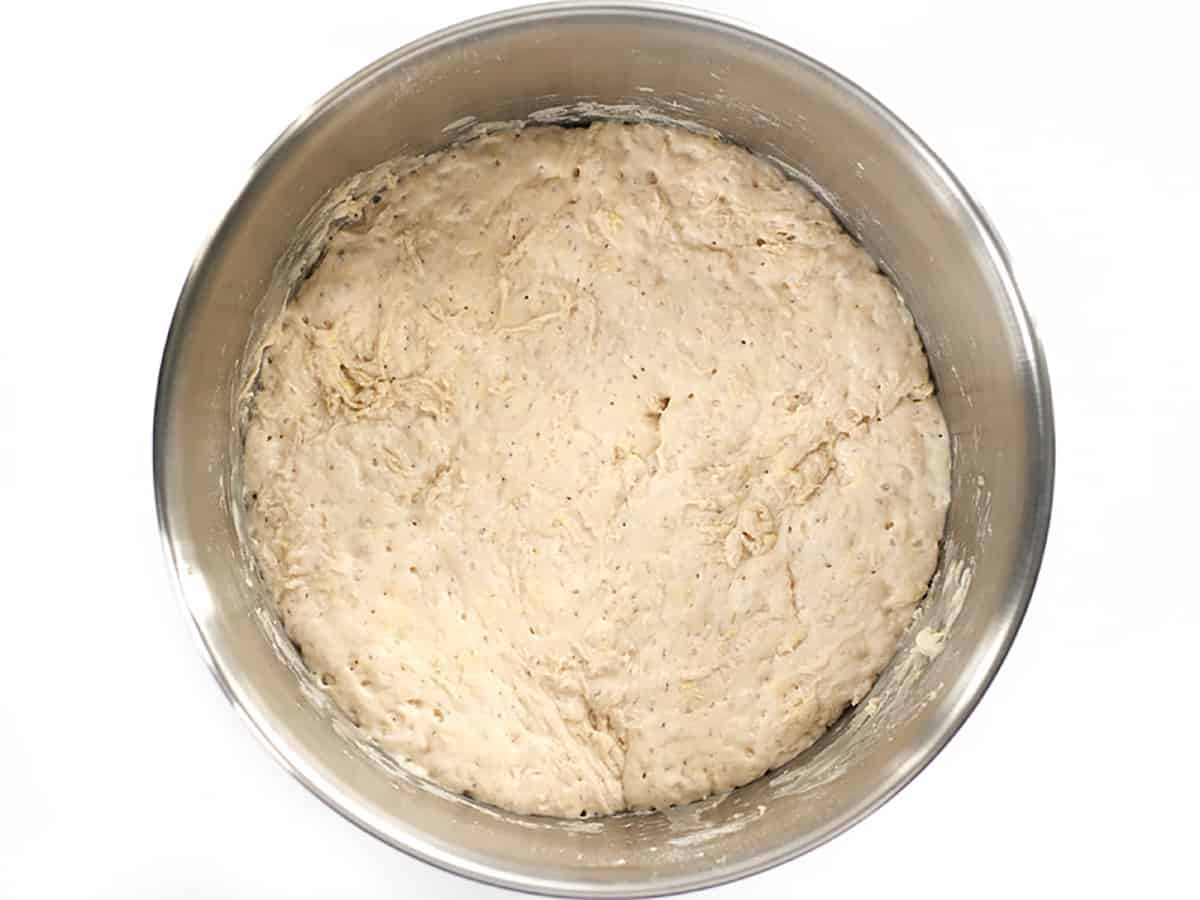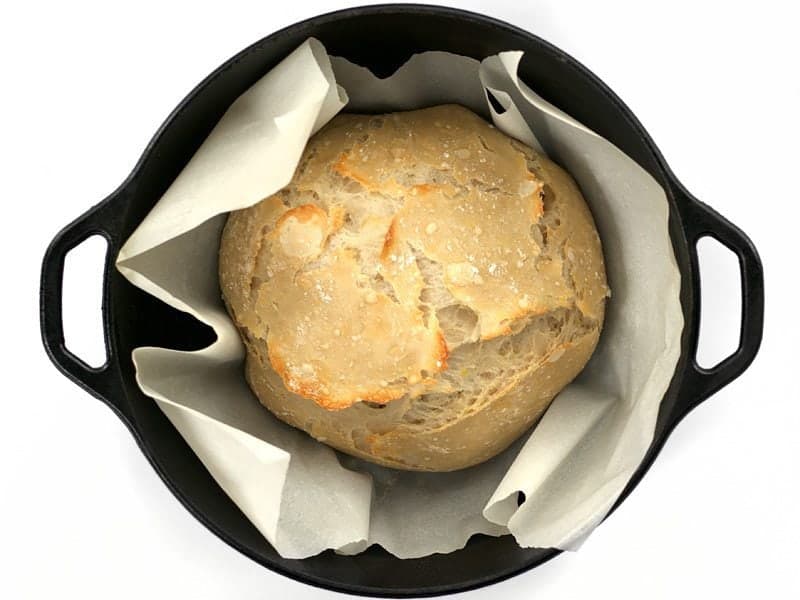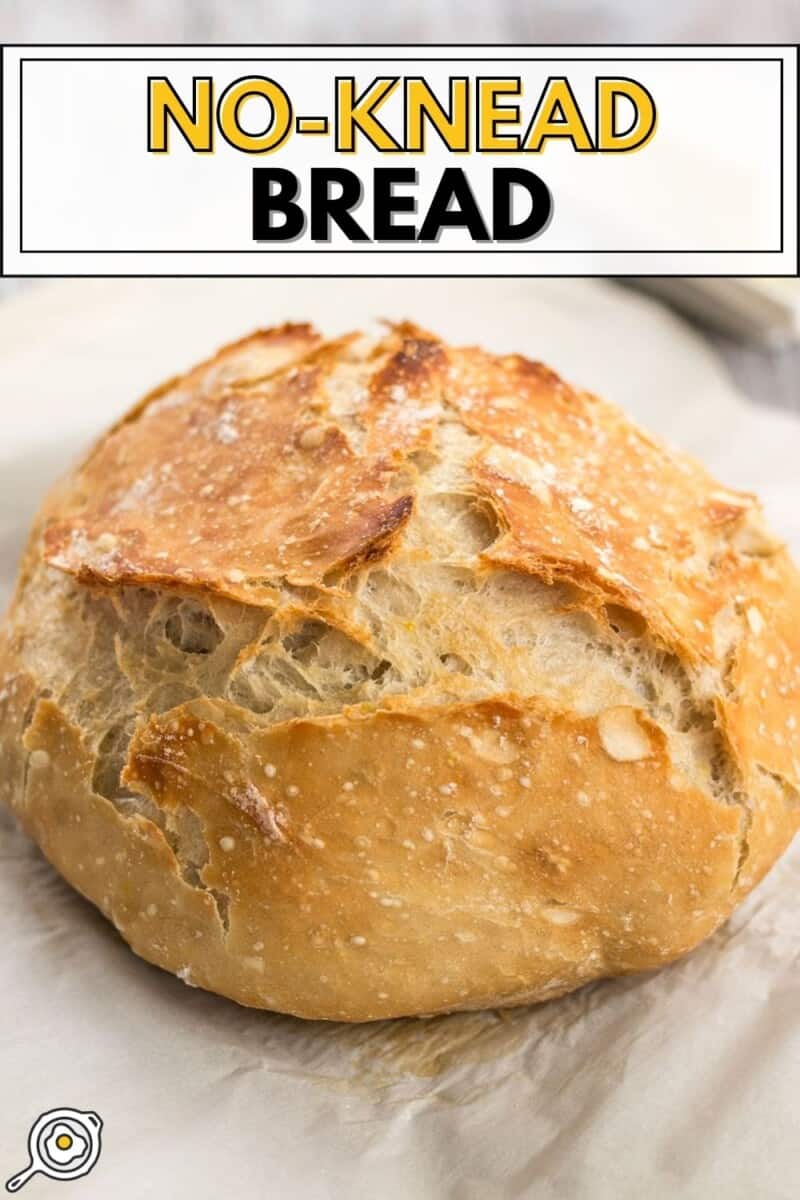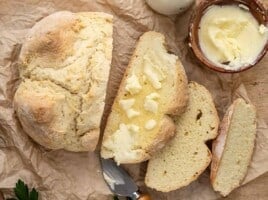I started making no-knead bread in 2010 and it has continued to be my favorite way to make homemade bread because it’s incredibly simple, it doesn’t require a lot of effort, and it makes the most deliciously crusty bakery-style bread ever. To make this no-knead bread recipe you only need four ingredients (including water) and a little bit of time. No fancy equipment or techniques needed!

This post contains some affiliate links, which means that we make a small commission off items you purchase at no additional cost to you.
“I’ve made this twice and it was amazing! Hard to believe something so simple can come together to be something so amazing!”
-Melissa
What Is No Knead Bread?
No-knead bread is an ancient technique for making delicious loaves of bread by utilizing a long fermentation time to develop the gluten the flour instead of hand kneading. Gluten is the protein that gives bread its strength, allowing it to rise into a fluffy loaf, and have that deliciously chewy texture. Kneading bread dough develops gluten quickly, but is quite labor-intensive. If given enough time, yeast can develop the gluten in the dough without the need for manual needing.
Ingredients for No Knead Bread
The best part about this no-knead bread recipe is that it only requires four ingredients, including water, and you still get an incredibly flavorful bread. Here’s all you’ll need to make your own homemade no-knead bread:
- Flour: Our version of no-knead bread was developed using all-purpose flour because that is what we most commonly have on hand. That being said, using bread flour will create even better results. Just keep in mind that bread flour tends to absorb more water than all-purpose flour, so you may need to adjust the ratios slightly.
- Yeast: For this type of bread, we use instant yeast or bread machine yeast, both of which do not need to be activated first by proofing in warm water. You can simply add them to your dry ingredients and go!
- Salt: Without the proper amount of salt, homemade bread will have no flavor, so it’s imperative that you do not skip the salt.
- Water: Water hydrates the flour to create the dough. Because this technique uses a longer ferment time, you can use room-temperature water and you do not have to “wake up” the yeast with warm water. The yeast will have plenty of time to activate as it rests.
What Kind of Yeast to Use
It’s very important to use the correct type of yeast for this recipe. Instant yeast and bread machine yeast are special because they do not require mixing with warm water to “wake up” before adding to a recipe. You can simply stir them into the dry ingredients and they will activate instantly upon hydration, so that is what we use for this super simple no-knead bread technique. Active Dry yeast, on the other hand, needs to be specifically activated in warm water first. If you use active dry yeast in this recipe using the technique below, the bread will likely not rise.
Do I Need to Use a Dutch Oven?
Using a preheated Dutch oven does create the best results because it gives the bread an extra intense boost of heat while retaining all of the moisture and steam. That being said, I have made no-knead bread on a sheet pan with great results! I suggest adding a pan with an inch or so of water on the bottom rack of your oven to create steam if you’re baking your bread on a sheet pan.
If possible, I would suggest investing in a Dutch Oven because they are easily one of the most flexible and useful pieces of cookware. We love our Amazon Basics 6-Quart Enameled Dutch Oven as a very affordable alternative to Le Creuset. Lodge also makes very affordable Enameled Dutch Ovens and plain Cast Iron Dutch Ovens (like the one used in the photos here).
Short Fermentation vs. Long Fermentation
You can make no-knead bread using either a long fermentation (12-18 hours) or a short fermentation (about 2 hours). The difference is that you’ll need more yeast to do the short fermentation and the flavor does not develop quite as deeply. That being said, short fermentation no-knead bread is a great option when you haven’t planned ahead!
Long Fermenation: Follow the instructions below, using ¼ tsp yeast and fermenting the dough for 12-18 hours.
Short Fermentation: Use 2 tsp yeast (or one ¼ oz. packet) and ferment the dough for about 2 hours at room temperature.

No-Knead Bread

Ingredients
- 3 cups all-purpose flour ($0.29)
- 1/4 tsp instant yeast or bread machine yeast* ($0.02)
- 1.5 tsp salt ($0.02)
- 1.5 to 1.75 cup water** ($0.00)
Instructions
- The day before baking, combine the flour, yeast, and salt in a large bowl and stir until they're well combined. Stir in about 1.5 to 1.75 cups room temperature water until a shaggy, sticky ball of dough forms and there is no dry flour left on the bottom of the bowl. The dough should be wet and sticky, but not so wet that it appears glossy. Cover the bowl loosely with plastic and let it sit at room temperature for 12-18 hours.
- The next day, the dough should be fluffy and very bubbly. When you're ready to bake, sprinkle a little flour on top of the fermented dough and scrape it out of the bowl. With well-floured hands, shape the dough into a ball and place it on a piece of parchment paper. Let the dough rise for 30-60 minutes.
- While the dough is rising, preheat the oven to 425ºF, or the highest recommended temperature listed on the packaging for your parchment paper. Place the Dutch oven inside the oven as it preheats, and make sure it sits in the fully heated oven for at least 15 minutes before baking the bread.
- Once the bread has risen and the Dutch oven is fully heated, carefully remove the Dutch oven from the oven (it will be EXTREMELY hot). Lift the parchment with the dough straight into the dutch oven and cover it with the lid.
- Return the Dutch oven to the oven and bake for 30 minutes. Carefully remove the lid and bake for another 15-20 minutes, or until the crust is a deep golden brown. Remove the Dutch oven from the oven, lift the bread out by by using the parchment paper, and allow it to cool before cutting open and serving.
Sheet Pan Instructions
- Ferment and shape the dough as described above, then place it on a parchment-lined sheet pan to rise for an additional 30 minutes.
- Place a baking pan with about an inch of water on the bottom rack of the oven, then preheat to 425ºF while the dough rises.
- Once the loaf has risen for 30 minutes and the oven is fully preheated, carefully score the top of the dough with a sharp knife (use horizontal motions with no downward pressure). Transfer the sheet pan to the oven and bake for 40 minutes, or until the crust is deeply golden brown and the loaf sounds hollow when tapped.
See how we calculate recipe costs here.
Equipment
- Cast Iron Dutch Oven
- Mixing Bowls
- Parchment Paper
- Liquid Measuring Cup
Notes
Nutrition

How to Make No-Knead Bread – Step by Step Photos

Before you begin, make sure you have “instant yeast” or “bread machine yeast” rather than “active dry”. The reason you need this type of yeast specifically is because it does not need to be kick-started by mixing with warm water first. You can add it to a recipe dry and it will still activate. I buy these little jars, which I keep in my fridge, and they last for-ev-er (especially when you’re only using 1/4 tsp at a time)!

The day before you want to actually bake the bread, combine 3 cups all-purpose flour, 1/4 tsp instant or bread machine yeast, and 1/2 Tbsp salt in a large bowl. Stir them together really well.

Stir in about 1.5 to 1.75 cups of room temperature water, or just enough to form a shaggy ball of slightly sticky dough, and no dry flour is left on the bottom of the bowl. The total amount of water needed may vary from time to time depending on the ambient humidity and moisture content of the flour, so go on visuals here. Make sure it comes together in one ball and no dry flour is left on the bottom of the bowl. It’s okay for it to be a bit sticky.

Loosely cover the bowl with plastic and let the dough ferment at room temperature for 12-18 hours. If you need to let it sit longer than that to fit your schedule, just transfer it to the refrigerator. As the dough ferments, it becomes very big, light, fluffy, and bubbly.

Sprinkle a little flour onto the dough (because it will be sticky) and scrape it out of the bowl. It will begin to deflate as you scrape it out.

Using floured hands, shape the dough into a ball, then place it on a large piece of parchment. Let the dough rise for 30-60 minutes. The shorter rise time will produce a slightly more dense bread and the longer rise time will have larger bubbles.

While the dough is rising, begin to preheat the oven and the Dutch oven. Set the oven to 425ºF, or whatever the highest safest temperature is for your brand of parchment (it will usually be listed on the box somewhere). Make sure your Dutch oven is inside the oven as it preheats, and then let it heat for an additional 15 minutes or so once the oven is up to temperature. This makes sure that the Dutch oven is nice and hot.

When the dough is risen and the Dutch oven is fully preheated, carefully remove the Dutch oven from the oven (it will be extremely hot!). Lift the risen dough by the parchment and place it inside the Dutch oven, parchment and all. Place the lid on the Dutch oven and return it to the hot oven.

Let it bake for 30 minutes with the lid on the Dutch Oven, then carefully remove the lid…

Then bake it for an additional 15 minutes or so WITHOUT the lid to allow the crust to brown.

Once the crust achieves a nice deep golden brown color, carefully remove the Dutch Oven from the oven. Lift the no-knead bread out of the Dutch oven by the parchment, and allow it to cool before serving.

And just be prepared for the BEST bread you’ve ever made yourself. ;) The crust on this no-knead bread is seriously amazing.
No Dutch Oven and Short Fermentation Instructions
So, as I mentioned before, you can still bake this bread without a Dutch oven and with a short, 2-hour fermentation time. Here is a photo of my no-knead bread using just 2 hours of fermentation (plus another 1 hr rise time) and baked on a baking sheet.

If you only have about 2-3 hours to ferment the dough, you’ll need to increase the amount of yeast used to 2 tsp (instead of 1/4 tsp).
Let the dough ferment in the bowl for 2 hours, then shape it into a loaf, transfer it to a baking sheet covered with parchment (and sprinkled with cornmeal, if desired) and let rise for about another hour. I like to make slits in the top with a sharp knife after the loaf has risen. Be careful though, if the knife is not sharp enough or you use too much downward pressure, it can deflate the dough.
Brush the surface of the dough with water, then bake it in a preheated oven (again, as hot as the parchment will allow, usually around 425ºF) for 30-40 minutes, or until the crust is nicely browned.







Beth, this is cooling on the counter now. Shaped into a long loaf, brushed with oil, spritzed with water while baking at 424 for about 25 minutes. Looks fantastic. Nice crust, feels like a nice crumb. Can’t wait to attack it!
Did you make a change to your blog yesterday or early today. The layout after clicking on recipes is not as user friendly. Or I wonder if a Microsoft update changed how it looks on my computer.
Hey Beth, I love your recipes and thanks to you I made naan for the first time this week. I would like to make this bread and was wondering after reading your update, are the water pans still needed in the oven when baking? Thanks!
Nope, instead I brushed the surface of the loaf with water before putting it in the oven. That created even more moisture and made the crackly crust. :)
Hiya!
I’m planning to make this for the first time, but I’m a little confused on one point – it says let it sit for 2 hours, but if you don’t refridgerate it, then the next step on the list is letting it rise 45 minutes.
Is the additional 45 minutes necessary if you haven’t refridgerated it?
Yep, you want the formed loaf to rise again because as you shape it, it will deflate.
Thanks!
I’ve made this a bunch of times now – it’s so tasty and easy it’s addictive. I did find I had some trouble getting a non-gummy crumb at first, but have found that if I plop a tablespoon of unsweetened/natural applesauce in, it works every time. Go figure :)
Interesting! I’m going to try that!
Dinner rolls? Did someone say dinner rolls? Never even considered that! So for dinner rolls, I’m guessing I would just cut the dough into smaller pieces and shape/cut them. Any idea what adjustments might need to be made to baking time?
Hi Edee, I’ve made quite a fe no-knead breads since this original post and I’ve found this version is the best for dinner rolls. I hope you enjoy them!
I second the opinion of a couple of readers, dutch ovens work fantastically for this type of bread. Also, I find that if I let mine proof for 12-18 hours, it’s extra fluffy and delicious on the inside.
Love your site, thanks!
I’m making this right now. I’ve had it baking longer than the 30 min time, but it just won’t brown up nicely. But it smells amazing! What did I do wrong that it’s not browning as it bakes?
I’ve noticed that this recipe in particular takes longer to brown. I think it’s because the dough is so high moisture and it’s a little more dense that most bread doughs, so it takes the crust longer to dry out and brown.
Try using a cast iron dutch oven instead of a baking sheet, works brilliantly
Thank you for the tips, particularly the one about brushing on the water! Yummy, yum, yum, YUM!
Excellent suggestions, Carnifex! I can’t wait to try honey (I’m a honey fanatic)! :)
Your no-knead recipe inspired me to start baking bread! Before trying your above recipe I always thought bread would be “too difficult.” Six months later a fresh, homemade roll is my standard breakfast! I still use this recipe as the base, albeit with my own modifications. I’m not an expert baker, but I keep trying to improve–and it’s a delicious learning process! :)
Along with saying “thank you,” I want to suggest a change. Add honey to the dough! This produces a thicker and chewier crust, which I think improves on the recipe as written.
I mix approx. 1 to 2 Tbsp honey into the amount of water I’m using in the recipe. The water should be warm but not hot; this makes the honey dissolve easily and also helps the yeast “wake up” quickly. (Be careful, boiling hot water will kill yeast. You should be able to put your finger in the water without discomfort.)
I prefer about 1 Tbsp honey because I don’t want to add too much sweetness. But the precise amount is not important. Experiment and see what you like best!
Anon – You could bake it on a baking sheet with some parchment and skip the cornmeal.
Would it be possible to use flour in place of cornmeal? I like the taste, but sometimes it’s not on hand and an alternative would be very good to have!
I just made this bread with 1.5 cups whole wheat and 1.75 cups unbleached all purpose- so good! I just used a cookie sheet and the cornmeal gave the bottom a delicious chewy texture. I’ll definitely make this bread again. Thanks!
I’m trying this for dinner tonight, rolls are currently rising. I’m planning to use my stoneware cookie sheet for the bake. After reading through your blog about the slate I thought I might impart a little knowledge about tile. Quarry tile is not tile that is mined in a quarry nor are baking stones generally made of stone. Both of these are sort of misnomers. Quarry is a type of non porus kiln fired tile used in commercial kit hen applications and baking “stones” are actually ceramic “stoneware.” Any peice of tile made of actual stone is likely to fracture when subjected to the heat of an oven, but ceramic bakeware is kiln fired at much higher temperatures than what they see in your oven, thus allowing them to withstand the heat of cooking food, provided, of course, that you heat the stone gradually with the preheating oven.
My apologies if I missed this in another comment.
We had the EXACT same experience with the slate stone. Didn’t want to spend the money, saw the same Alton Brown episode you mentioned… looked for the tiles he mentioned, couldn’t find them, and came home with the same thing. KABLOOOOOOEY!!! Thankfully we heard it snap, crackle and popping as the oven preheated, and my husband quickly grabbed a pair of tongs, and was able to grab it and fling it out he back door (located RIGHT next to the oven) before it completely exploded. It actually continued to pop and crackle and explode in the backyard while it cooled down…